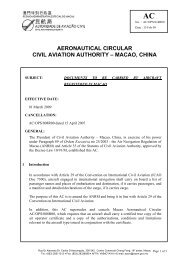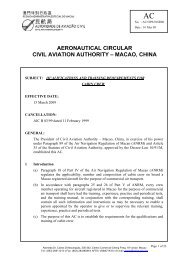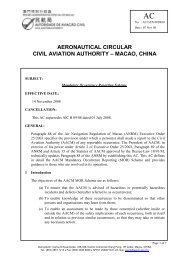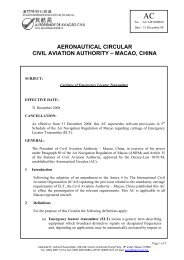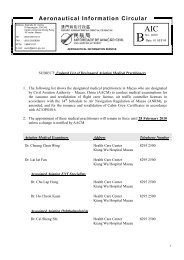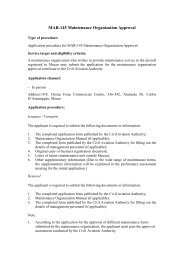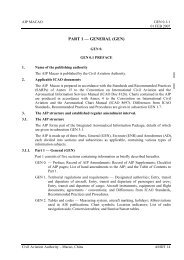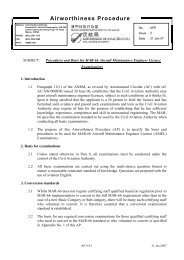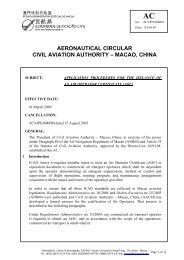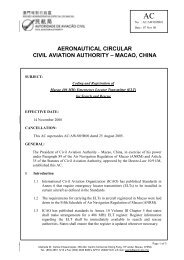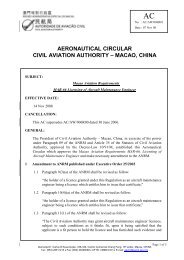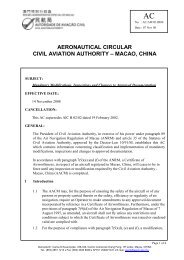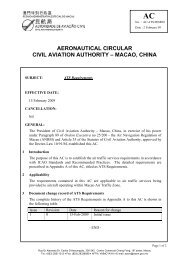Aviation Fuel at Aerodromes - Storage, Handling and Quality Control
Aviation Fuel at Aerodromes - Storage, Handling and Quality Control
Aviation Fuel at Aerodromes - Storage, Handling and Quality Control
You also want an ePaper? Increase the reach of your titles
YUMPU automatically turns print PDFs into web optimized ePapers that Google loves.
Chapter 6 Barrelled Supplies<br />
1 Delivery, <strong>H<strong>and</strong>ling</strong> <strong>and</strong> <strong>Storage</strong><br />
1.1 A barrel is generally considered to be a container having a capacity less than 210<br />
litres. Barrels storing avi<strong>at</strong>ion fuel should be distinctly coloured according to<br />
grade.<br />
1.2 Before acceptance, barrels should be examined for damage <strong>and</strong> seal integrity.<br />
Grade marking <strong>and</strong> inspector's identific<strong>at</strong>ion should cross check with details on<br />
the delivery note <strong>and</strong> release certific<strong>at</strong>e.<br />
1.3 Barrels should be stored under cover, clear of the ground <strong>and</strong> on their sides with<br />
both bungs below the liquid level.<br />
1.4 A storage system should be adopted th<strong>at</strong> will use the oldest fuel first, according<br />
to b<strong>at</strong>ch number <strong>and</strong> filling d<strong>at</strong>e.<br />
1.5 Different grades of fuel should be separ<strong>at</strong>ed from each other to minimise the risk<br />
of fuelling error.<br />
1.6 B<strong>at</strong>ches of AVGAS require labor<strong>at</strong>ory testing six months after the filling d<strong>at</strong>e<br />
with periodic six monthly checks thereafter. For Jet A-1 the testing period is<br />
every twelve months. After sampling the barrels must be resealed.<br />
2 Sampling<br />
2.1 Before sampling, check th<strong>at</strong> the seals are intact then st<strong>and</strong> the barrel on end <strong>and</strong><br />
wipe clean the area adjacent to the bung. Allow the contents to settle before<br />
drawing off the required quantity of fuel. Sampling procedures should be in<br />
accordance with Chapter 7.<br />
2.2 Discolour<strong>at</strong>ion of the fuel, or the presence of w<strong>at</strong>er or dirt in the sample<br />
indic<strong>at</strong>es th<strong>at</strong> the fuel is unfit for avi<strong>at</strong>ion use <strong>and</strong> therefore the barrel must be<br />
rejected.<br />
3 Decanting <strong>and</strong> Dispensing<br />
3.1 <strong>Fuel</strong> should preferably be decanted from barrels into fuelling vehicles or storage<br />
by means of a suitable pump <strong>and</strong> lines fitted with a microfilter or filter separ<strong>at</strong>or.<br />
AVGAS may altern<strong>at</strong>ively be decanted through a funnel fitted with an 80<br />
micron filter.<br />
3.2 When it is necessary to dispense fuel direct from barrel to aircraft, the barrels<br />
should be stood on end <strong>and</strong> the contents allowed to settle for ten minutes before<br />
taking samples. Once a s<strong>at</strong>isfactory sample has been obtained fuel may then be<br />
dispensed to the aircraft tanks through a suction st<strong>and</strong>pipe designed so th<strong>at</strong> fuel<br />
cannot be drawn from below a depth of 75mm from the barrel bottom.<br />
3.3 Delivery of AVGAS or JET A-1 to an aircraft should be via a filter monitor type<br />
element or equivalent filter. Additionally, Jet A-1 delivery should be through a<br />
Appendix 1-17



